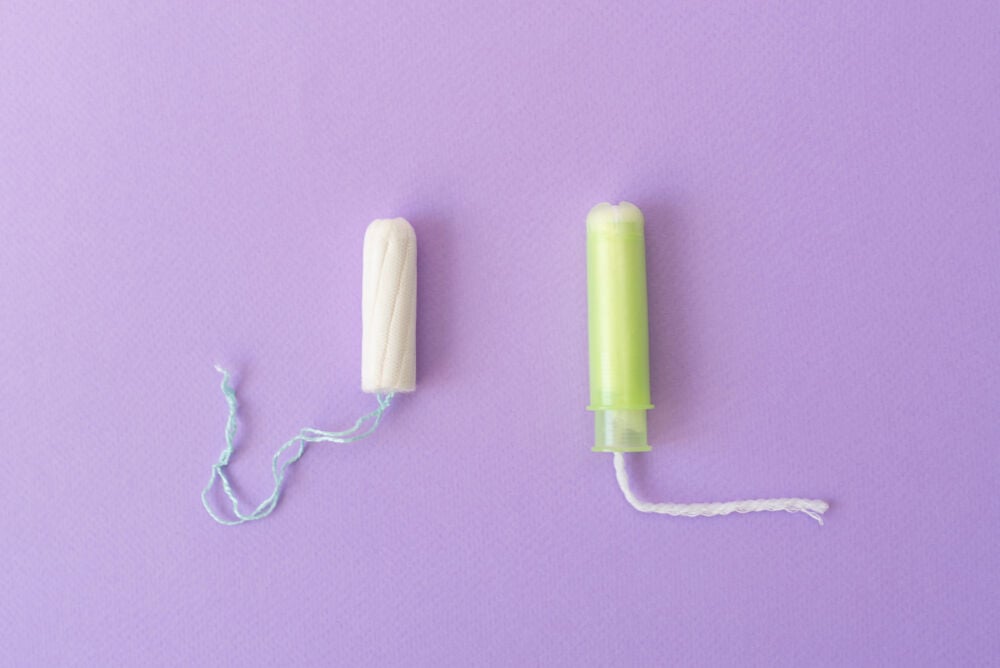It’s quite common to wonder how to use a tampon for the first time. Our comprehensive guide will explain how to insert a tampon properly and choose the right size.
-
Tracking cycle
-
Getting pregnant
-
Pregnancy
-
Help Center
-
Flo for Partners
-
Anonymous Mode
-
Flo app reviews
-
Flo Premium New
-
Secret Chats New
-
Symptom Checker New
-
Your cycle
-
Health 360°
-
Getting pregnant
-
Pregnancy
-
Being a mom
-
LGBTQ+
-
Quizzes
-
Ovulation calculator
-
hCG calculator
-
Pregnancy test calculator
-
Menstrual cycle calculator
-
Period calculator
-
Implantation calculator
-
Pregnancy weeks to months calculator
-
Pregnancy due date calculator
-
IVF and FET due date calculator
-
Due date calculator by ultrasound
-
Medical Affairs
-
Science & Research
-
Pass It On Project New
-
Privacy Portal
-
Press Center
-
Flo Accuracy
-
Careers
-
Contact Us
How to Insert a Tampon: A Step-by-Step Guide


Every piece of content at Flo Health adheres to the highest editorial standards for language, style, and medical accuracy. To learn what we do to deliver the best health and lifestyle insights to you, check out our content review principles.
If you’ve never tried putting in a tampon before, you’re not alone. According to Euromonitor, pads are the more popular period product in America. The company found that in 2014, women between 12 and 54 years old bought an average of 111 pads each year, compared to 66 tampons.
Read on to learn how to use a tampon, what types of tampons are available, and how to choose the right ones.
Step 1: Choosing the right size

Not all tampons are the same. Different brands may feel different and have different size and material options. One thing all tampon brands have in common is that they provide different levels of absorbency. Each manufacturer may have slightly different names for their sizes, but generally tampons are grouped together as:
- Junior or slim, for very light days
- Regular, for normal flow
- Super, for heavy days
- Super plus/ultra, for very heavy flow
Each size indicates the amount of menstrual fluid it can absorb. If the tampon needs to be changed every few hours, it’s too small. If the maximum absorbency is still resulting in leaks, using a pad along with it can help prevent stains.
Some tampons are sold in multipacks, with different sizes of tampons in each box. For example, some may come with eight slim tampons for the first few days when periods may be lighter and multiple larger sizes for heavier flow days.
It can be helpful to keep multiple tampon sizes on hand to help prevent leaks. It also helps for unpredictable periods and irregular cycles.
Take a quiz
Find out what you can do with our Health Assistant
Step 2: Getting ready to put a tampon in
The first thing to do is wash your hands to prevent dirt and germs from getting into or near the vagina.
Step 3: Getting into a comfortable position
Next, get comfortable. That might mean putting one foot on the closed toilet seat, standing and spreading the legs with knees slightly bent, or simply sitting on the toilet.
Before we get into technique, let’s talk about anatomy. The tampon goes in the vaginal opening, located between the urethra, where pee comes out, and the anus. Using a mirror can be helpful to find exactly where the tampon goes. The vaginal opening usually looks more like an oval-shaped slit rather than a round hole.
The opening of the urethra is too small for a tampon, and the vagina is a single canal, so it’s not possible to put it in the wrong hole.
Step 4: Inserting a tampon

Tampons with applicators
Most tampons come with applicators made of cardboard or plastic. These applicators surround the cotton tampon and make it easier to insert it into the vagina.
Open the tampon wrapper and take a look at the tampon. You may be able to see the white cotton end of the tampon poking through one end of the applicator. At the other end, there should be a string, and the plastic or cardboard applicator surrounds the tampon itself. The applicator usually consists of two tubes, one inside the other.
Take the tampon in one hand and gently insert it into the vaginal opening (string side down) until you reach the small indentation on the applicator’s side, about halfway up. While holding onto the indentation with two fingers, push the applicator’s inner tube toward you with your index finger. As you do this, the tampon will slide out from the applicator and inside the body. Push gently and slowly until it stops, and then pull the applicator out. You can now throw the applicator away.
The string should be visible hanging down from the vagina. This is there to help remove the tampon later. Inserting a tampon should never hurt. If it does, it may mean it’s too absorbent or not inserted far enough. If part of the tampon is sticking out, push it in a bit farther.
If there’s resistance when inserting a tampon and the path isn't blocked by the inner lips of the vagina, there may be an underlying reason. In rare cases, it's possible to be born with a very small opening in the hymen, which prevents a tampon from being inserted. If you’re having trouble inserting a tampon and you think this might be the cause, make sure to visit a health care provider or gynecologist.
Non-applicator tampons
Some tampons are sold without applicators, but they may be more difficult to insert. Unwrap the tampon from the plastic.
Grab the string and pull it tight from left to right and top to bottom, which widens the base of the tampon and provides protection for your finger. Put your index finger in the pocket you’ve made by moving the string around, and hold the tampon between your thumb and middle finger.
Push the tampon inside with your index finger, and then slide your finger out. The string should hang down outside your body.
You shouldn’t be able to feel the tampon at all. If you do feel it, push it a little bit farther in.
Finally, wash your hands. You’re done!
Step 5: Removing a tampon
Tampons should be removed and changed every four to eight hours, depending on the flow. For a heavy flow, the tampon may need to be changed every few hours. Pads are better to use for longer periods (more than eight hours), such as when sleeping.
To remove the tampon, gently pull on the string that hangs outside the body until the tampon comes out. Then wrap it up in several layers of toilet paper, dispose of it in the trash, and wash your hands. If you’re in a public place, many stalls will have small trash cans for pads and tampons. Don’t ever flush a tampon; they can clog septic systems and some of them might not be biodegradable.
Why it’s important to change your tampon often
Tampons need to be changed frequently to prevent toxic shock syndrome (TSS). TSS is a rare life-threatening condition caused by specific bacterial toxins that can sometimes develop when tampons are left in too long.
Remember to change your tampon multiple times a day. To prevent leaks, consider moving up to a higher absorbency tampon for a few days to help manage the flow.
If the tampon is too absorbent, it can dry out the vagina, making it more likely to tear and increasing the risk of contracting TSS.
If you still have questions about how to insert a tampon, you can check out the instructions on the tampon packaging or ask a health care provider or gynecologist.


Hey, I'm Anique
I started using Flo app to track my period and ovulation because we wanted to have a baby.


The Flo app helped me learn about my body and spot ovulation signs during our conception journey.


I vividly
remember the day
that we switched
Flo into
Pregnancy Mode — it was
such a special
moment.
Real stories, real results
Learn how the Flo app became an amazing cheerleader for us on our conception journey.




